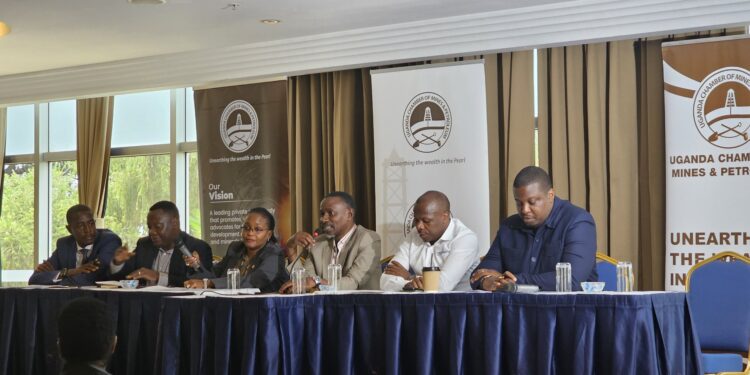Proscovia Nabanjja, the Chief Executive Officer, Uganda National Oil Company (UNOC), has revealed that Uganda is on track to produce its
first oil by 2025.
“We are working towards all efforts between the upstream and the EACOP. We are working towards the 2025 target, we are on track,” Nabanjja said at the launch of the 90 Days of Oil and Gas Media Campaign by the Uganda Chamber of Mines and Petroleum.
She noted that drilling has already started. Oil from will be transported via the $3.5 billion East African Crude Oil Pipeline (EACOP) to the port of Tanga in Tanzania for export.
The EACOP has the capacity to send up to 246,000 barrels of crude per day out to world markets by as early as 2025.
Nabanjja added that as UNOC, they have a diverse portfolio of projects stretching from upstream, midstream, and downstream.
“I just wanted to reassure you all that the sector has progressed. There has been fatigue before, but it’s now in action mode. And we encourage all Ugandans to take part. It’s not only about the direct benefits, their indirect and induced benefits, the sector is bringing $15 billion to 20 billion US dollars. We are likely to get anywhere above 50 billion within the lifetime of the projects. And that’s only assuming that the price of a barrel will be seated at about $50. you can see how much impact this industry is going to have on our economy,” Nabanjja said.
She added: “The drilling of the first Kingfisher well and also drilling some wells on Tilenga started. About 31 wells are intended to be drilled on Kingfisher, while on Tilenga, over 420 wells are planned. The intent again is to produce about 40,000 barrels of oil per day from Kingfisher and about 180,000 barrels of oil per day from Tilenga, giving us a total of anywhere between 230,000 and 240,000 barrels of oil per day. Out of that, 60,000 will go to the refinery, while the balance will go to the East African crude oil pipeline.”
Meanwhile, Jonan Kisakye, the Chief Executive Officer of Uganda Insurance Association, revealed that as a sector, they have benefited heavily since the announcement of the Final Investment Decision (FID).
“We have been able to issue three policies for the Tilenga project amounting to about $15.2 million, equal to about $2.7 million per loan, and for CNOCC, we are in the range of about $5.9 million in premiums,” he said.
Speaking at the same event, the General Secretary of the Chamber, Aggrey Ashaba, said the purpose of the campaign is to spotlight how much has been done since the FID and areas around ESG and human rights, in the Oil and Gas sector.
Humphrey Asiimwe, the Chief Executive Officer of UCMP said, as the oil and gas sector development phase gains momentum, a campaign of this nature is critical.
The third edition of this campaign is happening 19 months after the signing of the Final Investment Decision (FID) on the Lake Albert Development by TotalEnergies EP Uganda, CNOOC Uganda Limited, the Uganda National Oil Company (UNOC), and the Tanzania Petroleum Development Corporation (TPDC).
After the signing of FID, the government envisaged that between US$15-20bn would be invested in what it termed as the ‘development phase’ before first oil is achieved in 2025.
A significant amount of this money has so far been invested in the development of the Kingfisher and Tilenga projects in the Albertine Graben and the construction of the East African Crude Oil Pipeline (EACOP) and other sector projects.
The government hopes that investments after the FID will facilitate Uganda’s GDP growth by 22% and also unlock thousands of jobs and related opportunities.
Three rigs have been designated for the drilling operations on the Tilenga project – managed by TotalEnergies. Presently, SINOPEC 1501 is operational at the Jobi-5 well pad and commenced drilling operations on June 28, 2023.
For the Kingfisher Project – managed by CNOOC, the LR8001 rig has been operational since January 2023. Both rigs at Tilenga and Kingfisher have noise-suppressing technology and are fully automated and environmentally friendly.
Data from Petroleum Authority of Uganda (PAU) indicates that other midstream and downstream projects like the Kabalega International Airport are progressing, well above 90% completion rate; the Refinery Project – expected to refine 60,000 bopd at Kabaale is on course to get a joint venture partner; the East African Crude Oil Pipeline (EACOP) has made progress with land acquisition activities and payment of compensation for Project Affected Persons (PAPs) standing at 84% – the total number of PAPs is 3, 648, and those compensated are 3052 as of the end of July.
Other key activities include environment and livelihood restoration and improvement initiatives, transitional support, vocational training, and other support provided to the PAPs.
According to PAU data, as of the end of June, 12,949 people had been employed directly in the sector with Ugandans taking approx.94% of the jobs. A total of 3, 871 (excluding EACOP) are from host communities.
In addition, a total of over 14,000 Ugandans have been trained and certified in various oil and gas disciplines of Welding, Health Safety and Environment, Heavy Goods Vehicles, and more.
Cumulatively US$7.086bn has been approved for spending by the oil companies and US$1.762b (25%) of this is going to the Ugandan companies.
In the last 5 years, out of US$1.3bn of the smaller procurements, US$1.2bn has gone to Ugandan-owned companies (which is approx. 90%). Approx. 73% of the companies involved in supplying the sector have been Ugandan companies (460/624).
In addition, approx.US$988,658 has gone to the community economy through the provision of goods and services.








